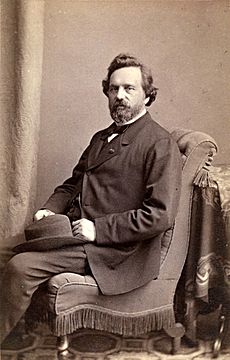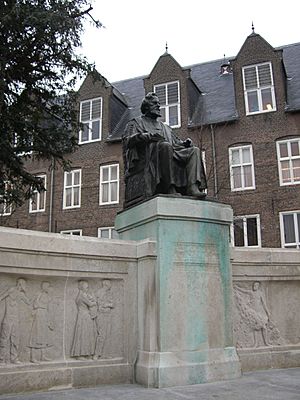Franciscus Donders facts for kids
Quick facts for kids
Franciscus Cornelis Donders
|
|
|---|---|

Franciscus Cornelis Donders
|
|
| Born | 27 May 1818 |
| Died | 24 March 1889 (aged 70) Utrecht, Netherlands
|
| Nationality | Dutch |
| Known for | Eye disease |
| Scientific career | |
| Fields | ophthalmology |
| Institutions | Utrecht University |
Franciscus (Franz) Cornelius Donders (born May 27, 1818 – died March 24, 1889) was a famous Dutch eye doctor, also known as an ophthalmologist. He taught physiology at Utrecht University in the Netherlands. Donders was known around the world for his knowledge of eye diseases. He even ran a special hospital for eye patients in the Netherlands. Along with other important scientists like Graefe and Helmholtz, he helped create the scientific study of eye care.
Contents
Early Life and Education
Franciscus Donders was born in Tilburg, a city in the Netherlands. His parents were Jan Franz Donders and Agnes Elizabeth Hegh. He went to school in Duizel and then to special schools called seminaries in Tilburg and Boxmeer.
When he was 17, Donders began studying medicine. He went to the School of Military in Utrecht. Here, he discovered he loved doing experiments, especially in chemistry. By the time he was 22, he joined the military to become a surgeon.
For several years, Donders studied at the Royal Dutch Hospital for Military Medicine in Utrecht. He earned his medical degree (M.D.) in 1840 from the University of Leiden. After working as a medical officer, he became a teacher in 1842. He taught physiology and anatomy at the Utrecht military medical school.
Becoming a Professor
Because of his great work, Donders made important connections. These connections helped him to do his own scientific research. In 1847, he became a professor at Utrecht University. By 1862, he became a full professor of physiology.
Donders believed that learning from textbooks was good. But he also knew that doing experiments made knowledge stronger and more real. He was one of the first to figure out that it takes a certain amount of time for our brains to process abstract thoughts.
Contributions to Eye Care
Donders is most famous for his work and research on eye diseases. He was one of the first doctors to use the ophthalmoscope. This is a tool that lets doctors look inside the eye.
He also invented a special tool called an impression tonometer in 1862. This tool helps measure pressure inside the eye. In 1860, he introduced special prismatic and cylindrical lenses. These lenses helped treat a common eye problem called astigmatism.
In 1858, Donders started a hospital for eye patients. It was called the Netherlands Hospital for Necessitous Eye-Patients. His first assistant there was Herman Snellen.
In 1864, Donders published a very important book. It was called "On the anomalies of accommodation and refraction of the eye." This book explained different problems with how the eye focuses and bends light. This book helped make eye care a proper medical field. It also made it easier for people to get the right eyeglasses.
Donders spent a lot of time studying biology and how our brains work. Even though he spent less time on eye care, his work had a huge impact. He introduced many ideas that are still used in eye medicine today. These ideas include:
- Refraction: How light bends as it enters the eye.
- Astigmatism: A common vision problem where the eye cannot focus light evenly.
- Accommodation: How the eye changes focus to see things at different distances.
- Ametropia: Any error in how the eye focuses light.
- Hypermetropia: Also known as farsightedness.
- Aphakia: When the eye is missing its lens.
- Presbyopia: Age-related difficulty in focusing on close objects.
- Convergence: How our eyes turn inward to look at close objects.
- Squint: When the eyes do not line up correctly.
He also created a formula to measure how sharp someone's vision is.
Donders' Law
One of his most important ideas is called "Donders' Law." This law explains how the eyeball rotates. It says that the way your eye turns depends on how far away an object is. It also depends on where it is in relation to the horizon. This law helps us understand how our eyes position themselves to look at different things. It ensures that the eye focuses on distant targets, even though there are many ways the eyes could position themselves.
Other ways Donders helped eye care include:
- Translating German medical textbooks into Dutch.
- Applying scientific knowledge to treat patients.
- Understanding different types of glaucoma, an eye disease.
- Studying how the brain works.
- Developing the "reduced eye" model, a simplified way to understand the eye's optics.
Understanding the Brain and Reaction Time
Donders was also the first to use differences in human reaction time to understand how our brains process information. He tested how fast people reacted to simple things. He also tested how fast they reacted when they had to make a choice. He found that simple reactions were faster.
This idea is now a key part of cognitive psychology. This field studies how we think, learn, and remember. Measuring reaction time is a common tool to learn about processes like learning, memory, and attention.
Donders created three ways to analyze reaction time:
- Task A (Simple): He would stimulate a participant's foot. Then he would measure how fast their hand reacted. People knew beforehand what to expect.
- Task B (Choice): He would stimulate the right hand and measure the response of the right foot. This task also measured how well someone could tell the difference between stimuli and make a decision.
- Task C (Go/No-go): He stimulated both feet. Participants were asked to respond with their right hand only when they felt stimulation in the right foot. They were told not to respond if they felt it in the left foot. This task measured their ability to detect a stimulus and give the correct response.
Donders found that the pattern of reaction times was A < C < B. This means simple reactions (A) were fastest. Choice reactions (B) were slowest. He believed that by comparing these times, scientists could figure out how long it takes to make a decision or tell the difference between things.
Other Contributions
Donders is also known in the dental world. He named the "space of Donders." This is the space between the back of your tongue and the roof of your mouth when your jaw is relaxed.
He passed away in Utrecht on March 24, 1889.
Family Life
Franciscus Donders was married two times. His first wife was Ernestine Zimmerman, who passed away in 1887. In 1888, he married Abrahamine Arnolda Louisa Hubrecht.


